Impacts Generated by a Large-Scale Solar Photovoltaic Power Plant Can Lead to Conflicts between Sustainable Development Goals: A Review of Key Lessons Learned in Madagascar
Abstract
1. Introduction
2. Methods and Context
3. Results
3.1. Local Impacts
3.1.1. Economic Impacts
3.1.2. Social Impacts
3.1.3. Environmental Impact
3.1.4. Energy Impacts
3.1.5. Impacts on Water and Food
3.1.6. Impacts on Governance and Land
3.1.7. Impacts on the Situation of Women
3.1.8. Conclusion of Local Aspects
3.2. Regional Impacts
3.3. National Impacts
3.4. International Impacts
3.5. Summary of Impacts
4. Discussion and Recommendations
4.1. Tensions between SDGs and Endogenous Development
4.2. Recommendations
5. Conclusions
Author Contributions
Funding
Acknowledgments
Conflicts of Interest
Appendix A
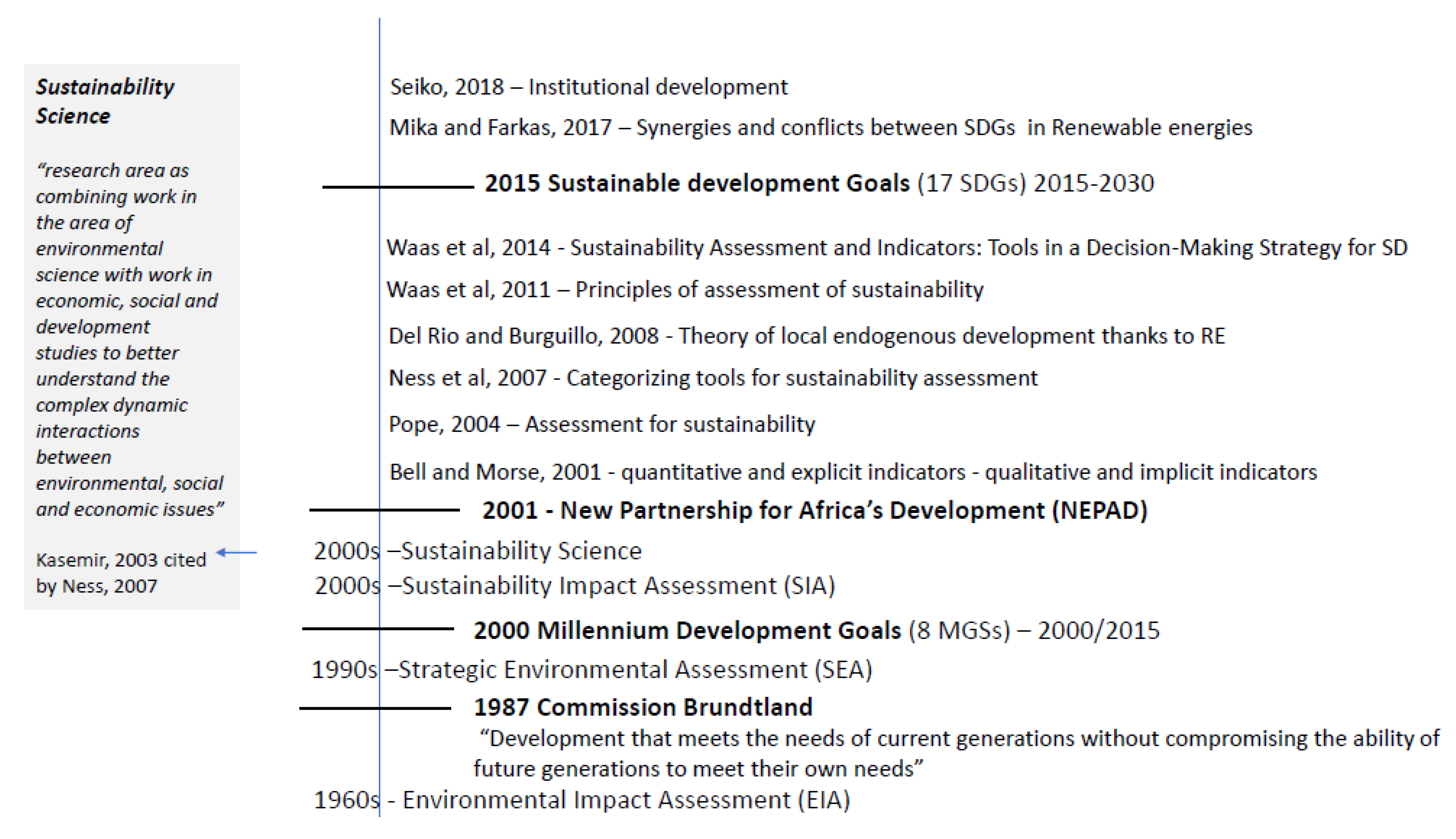
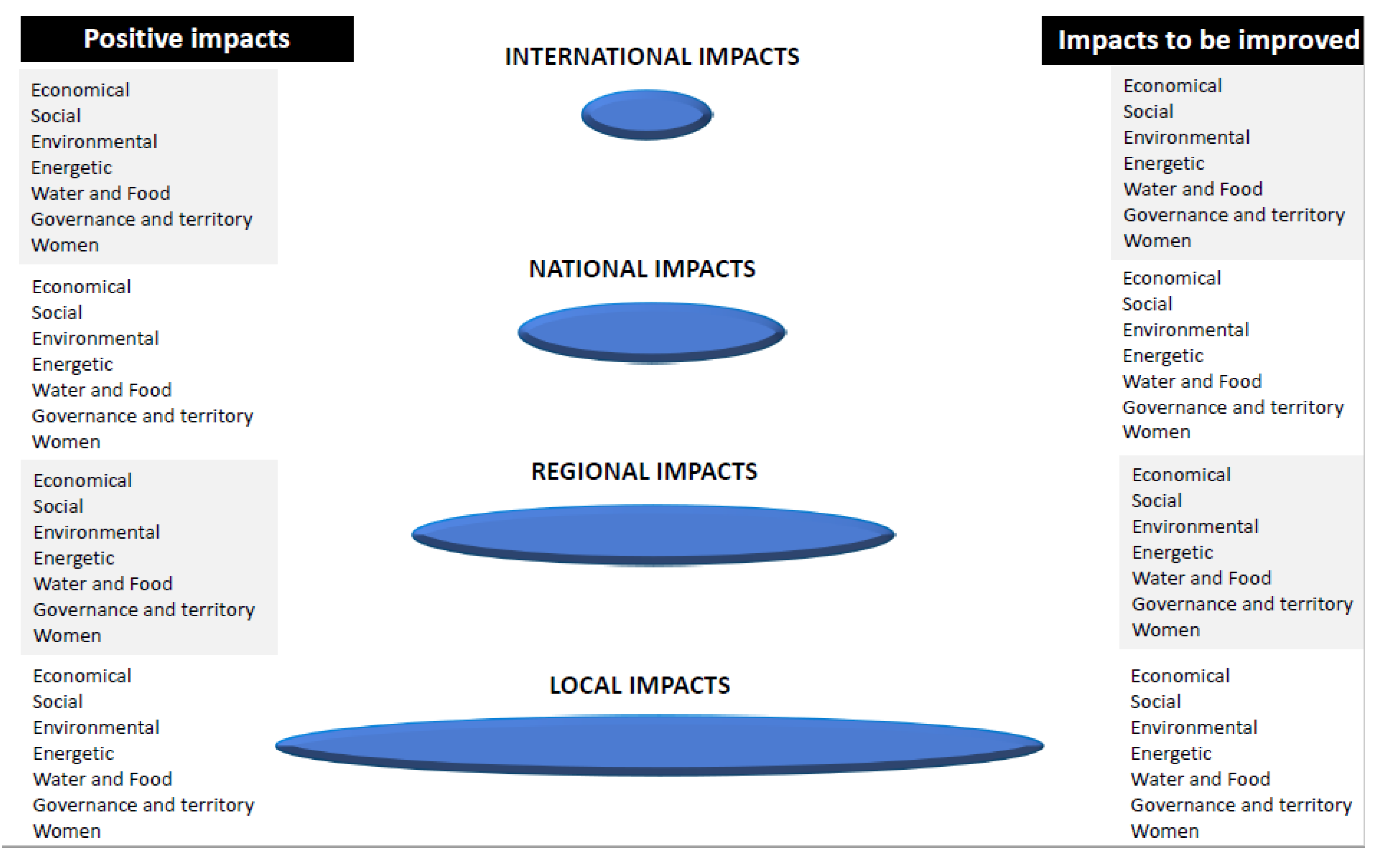

| Economic Impacts | |
|---|---|
| Local Level | |
| Positive Aspects | Negative Aspects |
|
|
| Social Impacts | |
|---|---|
| Local Level | |
| Positive Aspects | Negative Aspects |
|
|
| Impacts on the Environment | |
|---|---|
| Local Level | |
| Positive Aspects | Negative Aspects |
|
|
| Energy Impacts | |
|---|---|
| Local Level | |
| Positive Aspects | Negative Aspects |
|
|
| Impacts on Water and Food | |
|---|---|
| Local Level | |
| Positive Aspects | Negative Aspects |
| Water | |
|
|
| Food | |
|
|
| Impacts on Governance and Land | |
|---|---|
| Local Level | |
| Positive Aspects | Negative Aspects |
| Governance | |
|
|
| Land | |
|
|
| Impacts on Women | |
|---|---|
| Local Level | |
| Positive Aspects | Negative Aspects |
|
|
| Electrical Parameter | Meaning | Metric Unit | Symbol |
|---|---|---|---|
| Power | Ability—potential The rate at which work is done. | Watts Kilowatts Megawatts | W kW (= 1000 watts) MW (= 1,000,000 watts) |
| Energy Power used over a period of time multiplied by duration of use | How much energy used | Watt-hours Kilowatt-hours Megawatt-hours | Wh kWh (= 1000 Wh) MWh (= 1,000,000 Wh) Energy (kWh) = power (kW) x time used (h) |
References
- Lights, Power, Action; Africa Progress Panel: Geneva, Switzerland. 2016. Available online: https://www.africa50.com/fileadmin/uploads/africa50/Documents/Knowledge_Center/APP_Lights_Power_Action_2016__PDF.pdf (accessed on 1 March 2020).
- IRENA. Africa 2030: Roadmap for a Renewable Energy Future; IRENA: Abu Dhabi, UAE, 2015; Available online: https://www.irena.org/-/media/Files/IRENA/Agency/Publication/2015/IRENA_Africa_2030_REmap_2015_low-res.pdf (accessed on 1 March 2020).
- Rapport Annuel 2018—Vers un Développement Durable Basé sur une Transition Démocratique; PNUD Madagascar: Antananarivo. 2018. Available online: https://www.mg.undp.org/content/madagascar/fr/home/library/mdg/rapport-annuel-2018---pnud-madagascar---vers-un-developpement-du.html (accessed on 1 March 2020).
- Poorest Countries in Africa 2020. World Population Review. 2020. Available online: https://worldpopulationreview.com/country-rankings/poorest-countries-in-africa (accessed on 9 September 2020).
- Brunet, C.; Savadogo, O.; Baptiste, P.; Bouchard, M.A. Shedding some light on photovoltaic solar energy in Africa–A literature review. Renew. Sust. Energ. Rev. 2018, 96, 325–342. [Google Scholar] [CrossRef]
- Bawakyillenuo, S. Deconstructing the dichotomies of solar photovoltaic (PV) dissemination trajectories in Ghana, Kenya and Zimbabwe from the 1960s to 2007. Energy Policy 2012, 49, 410–421. [Google Scholar] [CrossRef]
- Mala, K.; Schläpfer, A.; Pryor, T. Better or worse? The role of solar photovoltaic (PV) systems in sustainable development: Case studies of remote atoll communities in Kiribati. Renew. Energy 2009, 34, 358–361. [Google Scholar] [CrossRef]
- Chaurey, A.; Kandpal, T.C. Assessment and evaluation of PV based decentralized rural electrification: An overview. Renew. Sust. Energ. Rev. 2010, 14, 2266–2278. [Google Scholar] [CrossRef]
- Rahman, M.M.; Paatero, J.V.; Lahdelma, R. Evaluation of choices for sustainable rural electrification in developing countries: A multicriteria approach. Energy Policy 2013, 59, 589–599. [Google Scholar] [CrossRef]
- Karekezi, S.; Kithyoma, W. Renewable energy strategies for rural Africa: Is a PV-led renewable energy strategy the right approach for providing modern energy to the rural poor of sub-Saharan Africa? Energy Policy 2002, 30, 1071–1086. [Google Scholar] [CrossRef]
- Mandelli, S.; Barbieri, J.; Mereu, R.; Colombo, E. Off-grid systems for rural electrification in developing countries: Definitions, classification and a comprehensive literature review. Renew. Sust. Energ. Rev. 2016, 58, 1621–1646. [Google Scholar] [CrossRef]
- Martinot, E.; Cabraal, A.; Mathur, S. World Bank/GEF solar home system projects: Experiences and lessons learned 1993–2000. Renew. Sust. Energ. Rev. 2001, 5, 39–57. [Google Scholar] [CrossRef]
- Nfah, E.M. Evaluation of optimal photovoltaic hybrid systems for remote villages in Far North Cameroon. Renew. Energy 2013, 51, 482–488. [Google Scholar] [CrossRef]
- Nieuwenhout, F.D.J.; van Dijk, A.; Lasschuit, P.E.; van Roekel, G.; van Dijk, V.P.A.; Hirsch, D.; Arriaza, H.; Hankins, M.; Sharma, B.D.; Wade, H. Experience with solar home systems in developing countries: A review. Prog. Photovolt. 2001, 9, 455–474. [Google Scholar] [CrossRef]
- Nkwetta, D.N.; Smyth, M.; Van Thong, V.; Driesen, J.; Belmans, R. Electricity supply, irregularities, and the prospect for solar energy and energy sustainability in Sub-Saharan Africa. J. Renew. Sustain. Ener. 2010, 2, 023102. [Google Scholar] [CrossRef]
- Akinyele, D.O.; Rayudu, R.K.; Nair, N.K.C. Global progress in photovoltaic technologies and the scenario of development of solar panel plant and module performance estimation—Application in Nigeria. Renew. Sust. Energ. Rev. 2015, 48, 112–139. [Google Scholar] [CrossRef]
- Hanger, S.; Komendantova, N.; Schinke, B.; Zejli, D.; Ihlal, A.; Patt, A. Community acceptance of large-scale solar energy installations in developing countries: Evidence from Morocco. Energy Res. Soc. Sci. 2016, 14, 80–89. [Google Scholar] [CrossRef]
- Baurzhan, S.; Jenkins, G.P. Off-grid solar PV: Is it an affordable or appropriate solution for rural electrification in Sub-Saharan African countries? Renew. Sust. Energ. Rev. 2016, 60, 1405–1418. [Google Scholar] [CrossRef]
- Stoms, D.M.; Dashiell, S.L.; Davis, F.W. Siting solar energy development to minimize biological impacts. Renew. Energy 2013, 57, 289–298. [Google Scholar] [CrossRef]
- Torres-Sibille, A.d.C.; Cloquell-Ballester, V.-A.; Cloquell-Ballester, V.-A.; Artacho Ramirez, M.Á. Aesthetic impact assessment of solar power plants: An objective and a subjective approach. Renew. Sust. Energ. Rev. 2009, 13, 986–999. [Google Scholar] [CrossRef]
- Rodrigues, M.; Montañés, C.; Fueyo, N. A method for the assessment of the visual impact caused by the large-scale deployment of renewable-energy facilities. Environ. Impact Assess. Rev. 2010, 30, 240–246. [Google Scholar] [CrossRef]
- Kaundinya, D.P.; Balachandra, P.; Ravindranath, N.H. Grid-connected versus stand-alone energy systems for decentralized power—A review of literature. Renew. Sust. Energ. Rev. 2009, 13, 2041–2050. [Google Scholar] [CrossRef]
- Eltawil, M.A.; Zhao, Z. Grid-connected photovoltaic power systems: Technical and potential problems—A review. Renew. Sust. Energ. Rev. 2010, 14, 112–129. [Google Scholar] [CrossRef]
- Cabrera-Tobar, A.; Bullich-Massagué, E.; Aragüés-Peñalba, M.; Gomis-Bellmunt, O. Review of advanced grid requirements for the integration of large scale photovoltaic power plants in the transmission system. Renew. Sust. Energ. Rev. 2016, 62, 971–987. [Google Scholar] [CrossRef]
- Yenneti, K.; Day, R.; Golubchikov, O. Spatial justice and the land politics of renewables: Dispossessing vulnerable communities through solar energy mega-projects. Geoforum 2016, 76, 90–99. [Google Scholar] [CrossRef]
- Stock, R.; Birkenholtz, T. The sun and the scythe: Energy dispossessions and the agrarian question of labor in solar parks. J. Peasant Stud. 2019, 1–24. [Google Scholar] [CrossRef]
- World Bank Group. Global Solar Atlas. Available online: https://olc.worldbank.org/content/global-solar-atlas (accessed on 1 March 2020).
- Kasemir, B.; Jaeger, C.C.; Jager, J. Citizen Participation in Sustainability Assessments. In Public Participation in Sustainability Science: A Handbook; Cambridge University Press: Cambridge, UK, 2003; pp. 3–36. Available online: https://www.cambridge.org/core/books/public-participation-in-sustainability-science/E6EDFED0D1F2A09A8123E0C31E40B907?__cf_chl_jschl_tk__=9ac74bb42f1e2baec58e3d3f881a430d3ba7415e-1599357538-0-AfNeL-Mb3nZUl2ATsjQIi5clN3fXhaQwU49xawdRALNeoj55Ukoerplemmv3XjrnyE7T4bx-u7o8cEay7WyDIbZxYoncXwDTCZD3en6x3LfqNDnfXWf_uBUg2lVr5MbMLNSRIZzs2RO9HGoYUW-9wm9aQRHoMcqvsBAVv6zL5Wt_7wl9U9ZzJBltNKtViahFS95p60O-0Q-lvmpt8JE_dWLR7HdVc1icjnLNK5CLW6bSGRebBJLtCvmCYfmmSl6IYMAoKrtx1c11pN9J9beXVpM0VKjsTv6uhfzi8fvmf0nCMQrX9sje8Ril6v9hLVtvF_FQXXAdu7oZ4oVZTC8sLWhg9LL9WT93_Ge_V5n6DbHv7nNEcE0i5rl8c3_mpCBy3LCnzUmmGBPB-6S4cpJnlim5F0UEtdEE4VoaroX_fzSvOuCv0D5Ry3v3vRYTZyoIXWre9Uov88jyrCIK6l4YQFQ (accessed on 1 March 2020).
- Ancient Roots, New Shoots: Endogenous Development in Practice; Haverkort, B., van’t Hooft, K., Hiemstra, W., Eds.; Zed Books: London, UK, 2003; Available online: http://www.bibalex.org/Search4Dev/files/416885/362467.pdf (accessed on 1 March 2020).
- Kates, R.W.; Clark, W.C.; Corell, R.; Hall, J.M.; Jaeger, C.C.; Lowe, I.; McCarthy, J.J.; Schellnhuber, H.J.; Bolin, B.; Dickson, N.M. Sustainability science. Science 2001, 292, 641–642. [Google Scholar] [CrossRef] [PubMed]
- Wiek, A.; Ness, B.; Schweizer-Ries, P.; Brand, F.S.; Farioli, F. From complex systems analysis to transformational change: A comparative appraisal of sustainability science projects. Sustain. Sci. 2012, 7, 5–24. [Google Scholar] [CrossRef]
- Lang, D.J.; Wiek, A.; Bergmann, M.; Stauffacher, M.; Martens, P.; Moll, P.; Swilling, M.; Thomas, C.J. Transdisciplinary research in sustainability science: Practice, principles, and challenges. Sustain. Sci. 2012, 7, 25–43. [Google Scholar] [CrossRef]
- Pope, J.; Annandale, D.; Morrison-Saunders, A. Conceptualising sustainability assessment. Environ. Impact Assess. Rev. 2004, 24, 595–616. [Google Scholar] [CrossRef]
- De Maio, J.L.; Scheld, S.; Woldeamanuel, M. Sustainability in Sub-Saharan Africa: Problems, Perspectives, and Prospects; Dendere, C., Dill, B., Khalil, H., Kyomugisha, F., Michaud, K., Nkulu-N’Sengha, M., Pope, B.D., Eds.; Rowman & Littlefield, 2018. Available online: https://books.google.com.hk/books/about/Sustainability_in_Sub_Saharan_Africa.html?id=cGx8DwAAQBAJ&redir_esc=y (accessed on 1 March 2020).
- Seiko, Z.M. Theories and Practices of Sustainable Development in Africa. In Handbook of Research on Sustainable Development and Governance Strategies for Economic Growth in Africa; 2018; pp. 1–29. Available online: https://www.igi-global.com/chapter/theories-and-practices-of-sustainable-development-in-africa/197581 (accessed on 1 March 2020).
- Gibson, R.B. Specification of Sustainability-Based Environmental Assessment Decision Criteria and Implications for Determining” Significance” in Environmental Assessment; Canadian Environmental Assessment Agency Ottawa. 2001. Available online: https://static.twoday.net/NE1BOKU0607/files/Gibson_Sustainability-EA.pdf (accessed on 1 March 2020).
- Waas, T.; Hugé, J.; Block, T.; Wright, T.; Benitez-Capistros, F.; Verbruggen, A. Sustainability assessment and indicators: Tools in a decision-making strategy for sustainable development. Sustainability 2014, 6, 5512–5534. [Google Scholar] [CrossRef]
- Waas, T.; Hugé, J.; Verbruggen, A.; Wright, T. Sustainable development: A bird’s eye view. Sustainability 2011, 3, 1637–1661. [Google Scholar] [CrossRef]
- Gendron, C.; Revéret, J.-P. Sustainable development. Econ. Soc. 2000, 37, 111–124. [Google Scholar]
- Drimie, S.; Mini, S. Food Security and Sustainable Development in Southern Africa; HSRC Press: Cape Town, South Africa, 2003; Volume 6, Available online: https://books.google.com.ph/books/about/Food_Security_and_Sustainable_Developmen.html?id=4Ldiqt3e4ZoC&redir_esc=y (accessed on 1 March 2020).
- Kates, R.W.; Dasgupta, P. African poverty: A grand challenge for sustainability science. Proc. Natl. Acad. Sci. USA 2007, 104, 16747–16750. [Google Scholar] [CrossRef]
- Riffon, O.; Villeneuve, C. Donner Voix aux Multiples Représentations du Développement Durable dans les Formations en Génie. Proc. Can. Eng. Educ. Assoc. (CEEA) 2013. Available online: https://www.researchgate.net/profile/Claude_Villeneuve/publication/315974574_DONNER_VOIX_AUX_MULTIPLES_REPRESENTATIONS_DU_DEVELOPPEMENT_DURABLE_DANS_LES_FORMATIONS_EN_GENIE/links/5a6659a3a6fdccb61c5a75ac/DONNER-VOIX-AUX-MULTIPLES-REPRESENTATIONS-DU-DEVELOPPEMENT-DURABLE-DANS-LES-FORMATIONS-EN-GENIE.pdf (accessed on 1 March 2020). [CrossRef]
- Riffon, O.; Villeneuve, C.; Une typologie du développement durable. Liaison Énergie Francoph. 2011. Available online: https://constellation.uqac.ca/2451/1/Une_typologie_du_d%C3%A9veloppement_durable.pdf (accessed on 1 March 2020).
- Gasparatos, A.; Takeuchi, K.; Elmqvist, T.; Fukushi, K.; Nagao, M.; Swanepoel, F.; Swilling, M.; Trotter, D.; von Blottnitz, H. Sustainability science for meeting Africa’s challenges: Setting the stage. Sustain. Sci. 2017, 12, 635–640. [Google Scholar] [CrossRef]
- Obasi, G.O. Embracing Sustainability Science. The Challenges for Africa. Environ. Sci. Policy Sustain. Dev. 2002, 44, 8–19. [Google Scholar] [CrossRef]
- Singh, R.K.; Murty, H.R.; Gupta, S.K.; Dikshit, A.K. An overview of sustainability assessment methodologies. Ecol. Indic. 2012, 15, 281–299. [Google Scholar] [CrossRef]
- Bell, S.; Morse, S. Sustainability Indicators: Measuring the Immeasurable? 2nd ed.; Routledge: London, UK; New York, NY, USA, 2012; Available online: https://www.routledge.com/Sustainability-Indicators-Measuring-the-Immeasurable-2nd-Edition/Bell-Morse/p/book/9781844072996 (accessed on 1 March 2020).
- Bell, S.; Morse, S. Breaking through the glass ceiling: Who really cares about sustainability indicators? Local Environ. 2001, 6, 291–309. [Google Scholar] [CrossRef]
- Ness, B.; Urbel-Piirsalu, E.; Anderberg, S.; Olsson, L. Categorising tools for sustainability assessment. Ecol. Econ. 2007, 60, 498–508. [Google Scholar] [CrossRef]
- Reed, M.S.; Fraser, E.D.G.; Dougill, A.J. An adaptive learning process for developing and applying sustainability indicators with local communities. Ecol. Econ. 2006, 59, 406–418. [Google Scholar] [CrossRef]
- Mori, K.; Christodoulou, A. Review of sustainability indices and indicators: Towards a new City Sustainability Index (CSI). Environ. Impact Assess. Rev. 2012, 32, 94–106. [Google Scholar] [CrossRef]
- Pissourios, I.A. An interdisciplinary study on indicators: A comparative review of quality-of-life, macroeconomic, environmental, welfare and sustainability indicators. Ecol. Indic. 2013, 34, 420–427. [Google Scholar] [CrossRef]
- Blanchet, D. La mesure de la soutenabilité. Revue de l’OFCE 2012, 120, 287–310. [Google Scholar] [CrossRef]
- Stiglitz, J.E.; Sen, A.K.; Fitoussi, J.-P. Report by the Commission on the Measurement of Economic Performance and Social Progress, Paris, France. 2009. Available online: https://www.cpc.unc.edu/projects/rlms-hse/publications/1921 (accessed on 1 March 2020).
- Santoyo-Castelazo, E.; Azapagic, A. Sustainability assessment of energy systems: Integrating environmental, economic and social aspects. J. Clean. Prod. 2014, 80, 119–138. [Google Scholar] [CrossRef]
- Liu, G. Development of a general sustainability indicator for renewable energy systems: A review. Renew. Sust. Energy Rev. 2014, 31, 611–621. [Google Scholar] [CrossRef]
- Iddrisu, I.; Bhattacharyya, S.C. Sustainable Energy Development Index: A multi-dimensional indicator for measuring sustainable energy development. Renew. Sust. Energy Rev. 2015, 50, 513–530. [Google Scholar] [CrossRef]
- Feron, S. Sustainability of off-grid photovoltaic systems for rural electrification in developing countries: A review. Sustainability 2016, 8, 1326. [Google Scholar] [CrossRef]
- Ilskog, E. Indicators for assessment of rural electrification—An approach for the comparison of apples and pears. Energy Policy 2008, 36, 2665–2673. [Google Scholar] [CrossRef]
- Terrapon-Pfaff, J.; Dienst, C.; Ortiz, W. The role of gender concerns in the planning of small-scale energy projects in developing countries. In Decentralized Solutions for Developing Economies; Groh, S., van der Straeten, J., Edlefsen Lasch, B., Gershenson, D., Leal Filho, W., Kammen, D., Eds.; Springer: Cham, Switzerland, 2015; pp. 285–294. [Google Scholar]
- Oparaocha, S.; Dutta, S. Gender and energy for sustainable development. Curr. Opin. Environ. Sustain. 2011, 3, 265–271. [Google Scholar] [CrossRef]
- Clancy, J.S.; Skutsch, M.; Batchelor, S. The Gender-Energy-Poverty Nexus: Finding the Energy to Address Gender Concerns in Development. DFID Project CNTR998521 2003. Available online: https://esmap.org/sites/default/files/resources-document/The%20Gender%20Energy%20Poverty%20Nexus.pdf (accessed on 1 March 2020).
- Glemarec, Y.; Bayat-Renoux, F.; Waissbein, O. Removing barriers to women entrepreneurs’ engagement in decentralized sustainable energy solutions for the poor. AIMS Energy 2016, 4, 136–172. [Google Scholar] [CrossRef]
- Takeuchi, K.; Aginam, O. Sustainability challenges and opportunities in Africa. Sustain. Sci. 2011, 6, 3–5. [Google Scholar] [CrossRef][Green Version]
- Yadoo, A.; Cruickshank, H. The role for low carbon electrification technologies in poverty reduction and climate change strategies: A focus on renewable energy mini-grids with case studies in Nepal, Peru and Kenya. Energy Policy 2012, 42, 591–602. [Google Scholar] [CrossRef]
- Jones, K.; Alexander, S.M.; Bennett, N.; Bishop, L.; Budden, A.; Cox, M.; Crosas, M.; Game, E.; Geary, J.; Hahn, C.; et al. Qualitative Data Sharing and Re-Use for Socio-Environmental Systems Research: A Synthesis of Opportunities, Challenges, Resources and Approaches. 2018. Available online: https://drum.lib.umd.edu/handle/1903/20257 (accessed on 1 March 2020).
- Eisenhardt, K.M. Building theories from case study research. Acad. Manag. Rev. 1989, 14, 532–550. [Google Scholar] [CrossRef]
- Ryan, G.W.; Bernard, H.R. Data management and analysis methods. In Handbook of Qualitative Research, 2nd ed.; Denzin, N.K., Lincoln, Y.S., Eds.; Sage Publications: Washington, DC, USA, 1994; Available online: https://utsc.utoronto.ca/~kmacd/IDSC10/Readings/Data%20analysis/methods.pdf (accessed on 1 March 2020).
- Yin, R.K. Case Study Research and Applications: Design and Methods, 6th ed.; Sage publications: Washington, DC, USA, 2017; Available online: https://www.amazon.com/Case-Study-Research-Applications-Methods/dp/1506336167 (accessed on 1 March 2020).
- Yin, R.K. Case study methods. In APA Handbooks in Psychology®. APA Handbook of Research Methods in Psychology; Cooper, H., Camic, P.M., Long, D.L., Panter, A.T., Rindskopf, D., Sher, K.J., Eds.; APA: Washington, DC, USA, 2012; Volume 2, pp. 141–155. Available online: https://psycnet.apa.org/record/2011-23864-009 (accessed on 1 March 2020).
- Sovacool, B.K.; Axsen, J.; Sorrell, S. Promoting novelty, rigor, and style in energy social science: Towards codes of practice for appropriate methods and research design. Energy Res. Soc. Sci. 2018, 45, 12–42. [Google Scholar] [CrossRef]
- Anadón, M.; Guillemette, F. La recherche qualitative est-elle nécessairement inductive. Rech. Qual. 2006, 5, 26–37. [Google Scholar]
- Surroop, D.; Raghoo, P. Renewable energy to improve energy situation in African island states. Renew. Sust. Energy Rev. 2018, 88, 176–183. [Google Scholar] [CrossRef]
- Surroop, D.; Raghoo, P.; Wolf, F.; Shah, K.U.; Jeetah, P. Energy access in Small Island Developing States: Status, barriers and policy measures. Environ. Dev. 2018, 27, 58–69. [Google Scholar] [CrossRef]
- Dornan, M. Access to electricity in Small Island Developing States of the Pacific: Issues and challenges. Renew. Sust. Energy Rev. 2014, 31, 726–735. [Google Scholar] [CrossRef]
- Praene, J.P.; Radanielina, M.H.; Rakotoson, V.R.; Andriamamonjy, A.L.; Sinama, F.; Morau, D.; Rakotondramiarana, H.T. Electricity generation from renewables in Madagascar: Opportunities and projections. Renew. Sust. Energy Rev. 2017, 76, 1066–1079. [Google Scholar] [CrossRef]
- Hammar, L.; Ehnberg, J.; Mavume, A.; Cuamba, B.C.; Molander, S. Renewable ocean energy in the Western Indian Ocean. Renew. Sust. Energy Rev. 2012, 16, 4938–4950. [Google Scholar] [CrossRef]
- IME. Structure de la Consommation d’Énergie à Madagascar. Available online: https://www.ime.mg/actus/structure-de-la-consommation.html (accessed on 1 March 2020).
- Investment Plan for Renewable Energy in Madagascar; Ministry Of Water, Energy and Hydrocarbons: Antananarivo, Madagascar, 2018; Available online: https://www.climateinvestmentfunds.org/sites/cif_enc/files/srepinvestment_plan_for_madagascar_final.pdf (accessed on 1 March 2020).
- LA BANQUE MONDIALE. La Force du Soleil. Madagascar se Lance dans la Production d’Énergie Renouvelable. Available online: https://www.banquemondiale.org/fr/news/feature/2018/10/10/the-force-of-the-sun-madagascar-embarks-on-renewable-energy-production (accessed on 1 March 2020).
- Antanarivo University. Pourquoi Madagascar reste pauvre malgré sa forte potentialité économique? Available online: https://www.ime.mg/actus/energie-renouvelables.html (accessed on 1 March 2020).
- Praene, J.P.; Radanielina, M.H.; Rakotondramiarana, H.T. Dish stirling system potential assessment for eight main sites in Madagascar. JP J. Heat Mass Transf. 2016, 13, 119–141. [Google Scholar] [CrossRef]
- De Souza, O. Madagascar: Trois Projets Solaires Seront installés avant la fin de cette Année. Agence Ecofin 2019. Available online: https://www.agenceecofin.com/solaire/2606-67321-madagascar-trois-projets-solaires-seront-installes-avant-la-fin-de-cette-annee (accessed on 1 March 2020).
- Fondation Énergies pour le Monde. De l’Électricité Verte pour un Million de Ruraux à Madagascar. Available online: http://www.fondem.ong/pdf/publication/Fondem-Brochure-Noria-Madagascar-2010.pdf (accessed on 1 March 2020).
- IRENA. Renewable Capacity Highlights. 2019. Available online: https://www.irena.org/-/media/Files/IRENA/Agency/Publication/2020/Mar/IRENA_RE_Capacity_Highlights_2020.pdf?la=en&hash=B6BDF8C3306D271327729B9F9C9AF5F1274FE30B (accessed on 1 March 2020).
- Kojima, M.; Trimble, C. Making Power Affordable for Africa and Viable for Its Utilities; The World Bank: Washington, DC, USA, 2016; Available online: https://openknowledge.worldbank.org/bitstream/handle/10986/25091/108555.pdf?sequence=5isAllowed=y (accessed on 1 March 2020).
- REN21. Renewables 2019 Global Status Report. 2019. Available online: https://www.ren21.net/wp-content/uploads/2019/05/gsr_2019_full_report_en.pdf (accessed on 1 March 2020).
- UNDP. Human Development Data. Available online: http://hdr.undp.org/en/data (accessed on 1 March 2020).
- UNEP. Atlas of Africa Energy Resources; United Nations Environment Programme: Nairobi, Kenya, 2017; Available online: https://www.icafrica.org/fileadmin/documents/Publications/Africa_Energy_Atlas.pdf (accessed on 1 March 2020).
- WB. Energy. Available online: https://www.worldbank.org/en/topic/energy/overview (accessed on 7 March 2019).
- WB. World Bank Open Data. Available online: https://data.worldbank.org/ (accessed on 1 March 2020).
- WB. The World Bank in Madagascar. Available online: https://www.worldbank.org/en/country/madagascar/overview (accessed on 1 March 2020).
- Harvey, C.A.; Rakotobe, Z.L.; Rao, N.S.; Dave, R.; Razafimahatratra, H.; Rabarijohn, R.H.; Rajaofara, H.; MacKinnon, J.L. Extreme vulnerability of smallholder farmers to agricultural risks and climate change in Madagascar. Phil. Trans. R. Soc. B 2014, 369, 20130089. [Google Scholar] [CrossRef]
- WB. Doing Business 2019: Training for Reform. 2019. Available online: https://openknowledge.worldbank.org/handle/10986/30438 (accessed on 1 March 2020).
- Index Mundi. Consommation d’électricité par habitant—Madagascar. Available online: https://www.indexmundi.com/map/?v=81000&r=xx&l=fr (accessed on 1 March 2020).
- Georgelin, A. Le Secteur de l’Énergie à Madagascar; Ambassade de France à Madagascar—Service Economique: 2016. Available online: https://ader.mg/pdf_files/infos/Energies_Renouvelables/Etudes/Etude_L’%C3%A9nergie_%C3%A0_Madagascar_enjeux_et_opportunit%C3%A9s_d’affaires_-_Version_FINALE_290816.pdf (accessed on 1 March 2020).
- ONE. Tableau de Bord Environnemental/Région. 2019. Available online: http://mg.chm-cbd.net/cooperation/initiatives/le-projet-combo/metadonnees-sur-la-biodiversite-en-vue-de-planifier-l-absence-de-perte-nette-et/theme-especes/faune-terrestre/tableau-de-bord-environnemental-region-1 (accessed on 1 March 2020).
- Pavlik, B.J.; Sangster, J.L.; Parsley, I.C.; Knudsen, E.M.; Ndrianajasoloarivony, Z.; Patterson, D.J.; Bartelt-Hunt, S.L.; Jones, E.G. Solar energy for rural Madagascar schools: A pilot implementation by university of Nebraska engineers without borders-USA. Int. J. Serv. Learn. Eng. Humanit. Eng. Soc. Entrep. 2013, 8, 24–42. [Google Scholar] [CrossRef][Green Version]
- Sourisseau, J.-M.; Rasolofo, P.; Belieres, J.-F.; Guengant, J.-P.; Ramanitriniony, H.K.; Bourgeois, R.; Razafimiarantsoa, T.T.; Andrianantoandro, V.T.; Ramarijaono, M.; Burnod, P.; et al. Diagnostic Territorial de la Région du Vakinankaratra à Madagascar; CIRAD, Institut International de Sciences Sociales. 2016. Available online: http://agritrop.cirad.fr/580518/1/Rapport%20diagnostic%20prospective%20Vakinankaratra_VFevrier2016.pdf (accessed on 1 March 2020).
- Antsa, R. 1.600 milliards Ar d’arriérés de la JIRAMA: Hausse des tarifs en vue pour les grands consommateurs. Available online: http://www.midi-madagasikara.mg/a-la-une/2019/09/25/1-600-milliards-ar-darrieres-de-la-jirama-hausse-des-tarifs-en-vue-pour-les-grands-consommateurs/ (accessed on 1 March 2020).
- Rahaga, N.A. Madagascar se dote de la plus grande centrale solaire de l’Océan Indien. Available online: https://www.madagascar-tribune.com/Madagascar-se-dote-de-la-plus,23979.html (accessed on 1 March 2020).
- Transparency International, Country Data, Madagascar, 2019 Rank. Available online: https://www.transparency.org/en/countries/madagascar# (accessed on 7 September 2020).
- Pradhan, P.; Costa, L.; Rybski, D.; Lucht, W.; Kropp, J.P. A systematic study of Sustainable Development Goal (SDG) interactions. Earth’s Future 2017, 5, 1169–1179. [Google Scholar] [CrossRef]
- Nilsson, M.; Griggs, D.; Visbeck, M. Policy: Map the interactions between Sustainable Development Goals. Nature 2016, 534, 320–322. [Google Scholar] [CrossRef] [PubMed]
- Mika, J.; Farkas, A. On synergies and conflicts between the sustainable development goals (2016-2030) and renewable energy sources for education of and by sustainability. Probl. Educ. 21st Century 2017, 75, 182–193. [Google Scholar]
- Millar, D. Endogenous development: Some issues of concern. Dev. Pract. 2014, 24, 637–647. [Google Scholar] [CrossRef]
- Del Río, P.; Burguillo, M. Assessing the impact of renewable energy deployment on local sustainability: Towards a theoretical framework. Renew. Sust. Energy Rev. 2008, 12, 1325–1344. [Google Scholar] [CrossRef]
- Tremblay, S. Du Concept de Développement au concept de l’Après-Développement: Trajectoire et Repères Théoriques; Université du Québec à Chicoutimi. 1999. Available online: https://constellation.uqac.ca/2029/ (accessed on 1 March 2020).
- Malunga, C.; Holcombe, S.H. Endogenous Development: Naïve Romanticism or Practical Route to Sustainable African Development; Routledge, 2017; Available online: https://www.routledge.com/Endogenous-Development-Naive-Romanticism-or-Practical-Route-to-Sustainable/Malunga-Holcombe/p/book/9781138294950 (accessed on 1 March 2020).
- Harris, J.M. Sustainability and sustainable development. In Internet Encyclopaedia of Ecological Economics; Aitken, A.C., Ed.; Internet Encyclopaedia of Ecological Economics, 2003; Available online: https://www.researchgate.net/publication/237398200_Sustainability_and_Sustainable_Development (accessed on 1 March 2020).
- Eberhard, A.; Naude, R. The South African Renewable Energy IPP Procurement Programme. 2017. Available online: https://www.researchgate.net/publication/316081773_The_South_African_Renewable_Energy_IPP_Procurement_programme (accessed on 7 September 2020).
- Wlokas, H.L.; Westoby, P.; Soal, S. Learning from the literature on community development for the implementation of community renewables in South Africa. J. Energy S. Afr. 2017, 28, 35–44. [Google Scholar] [CrossRef]
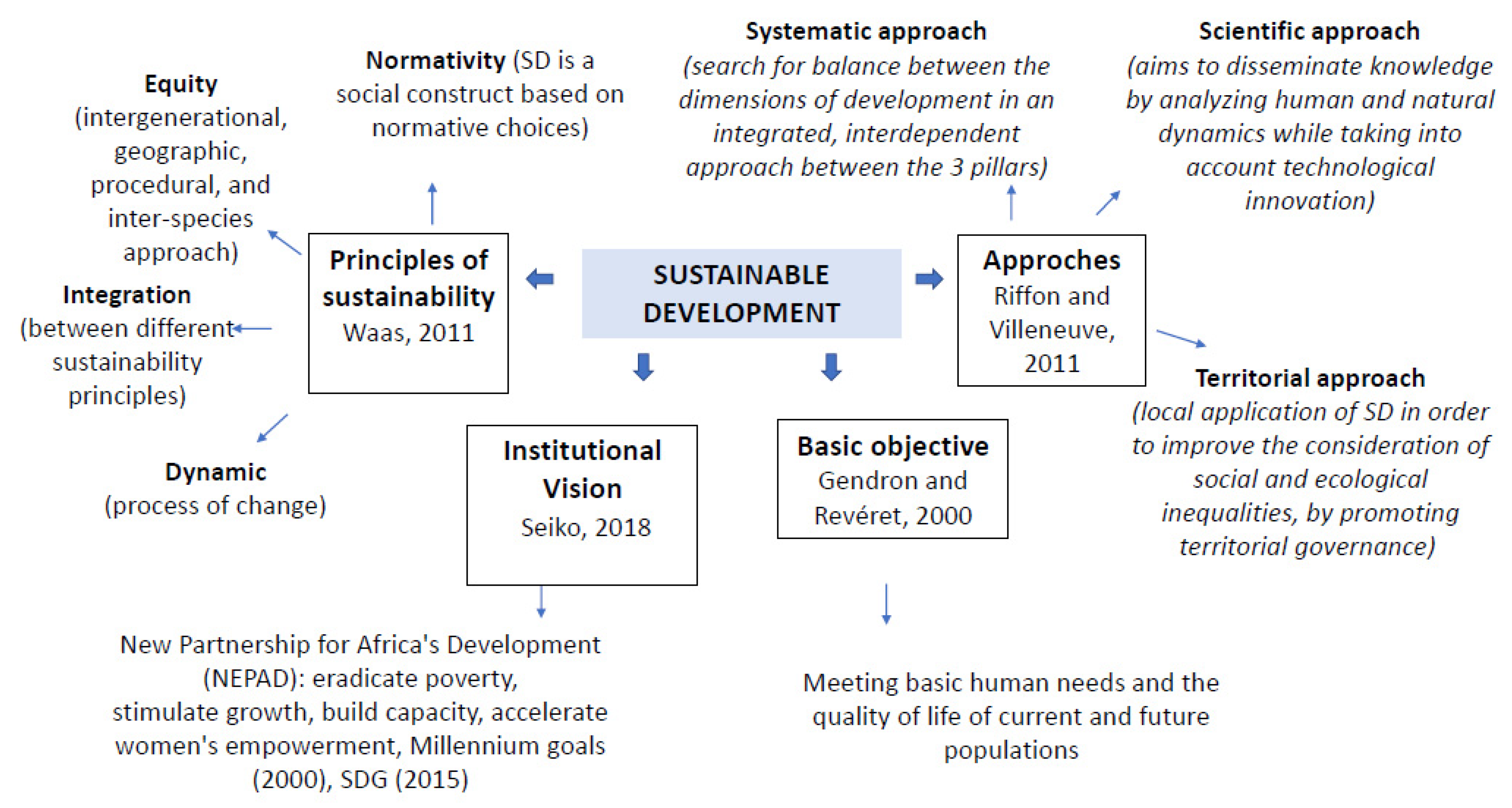
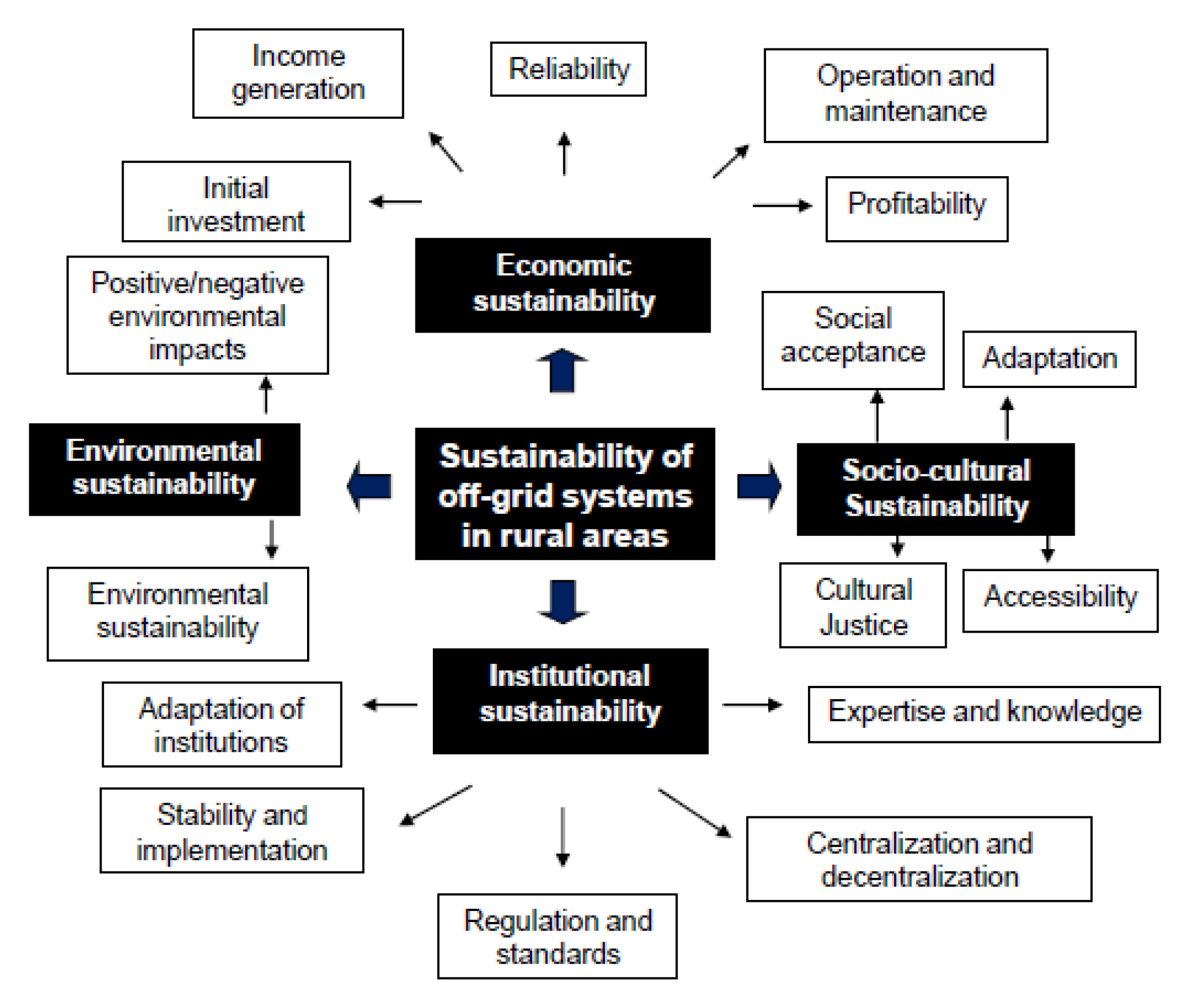
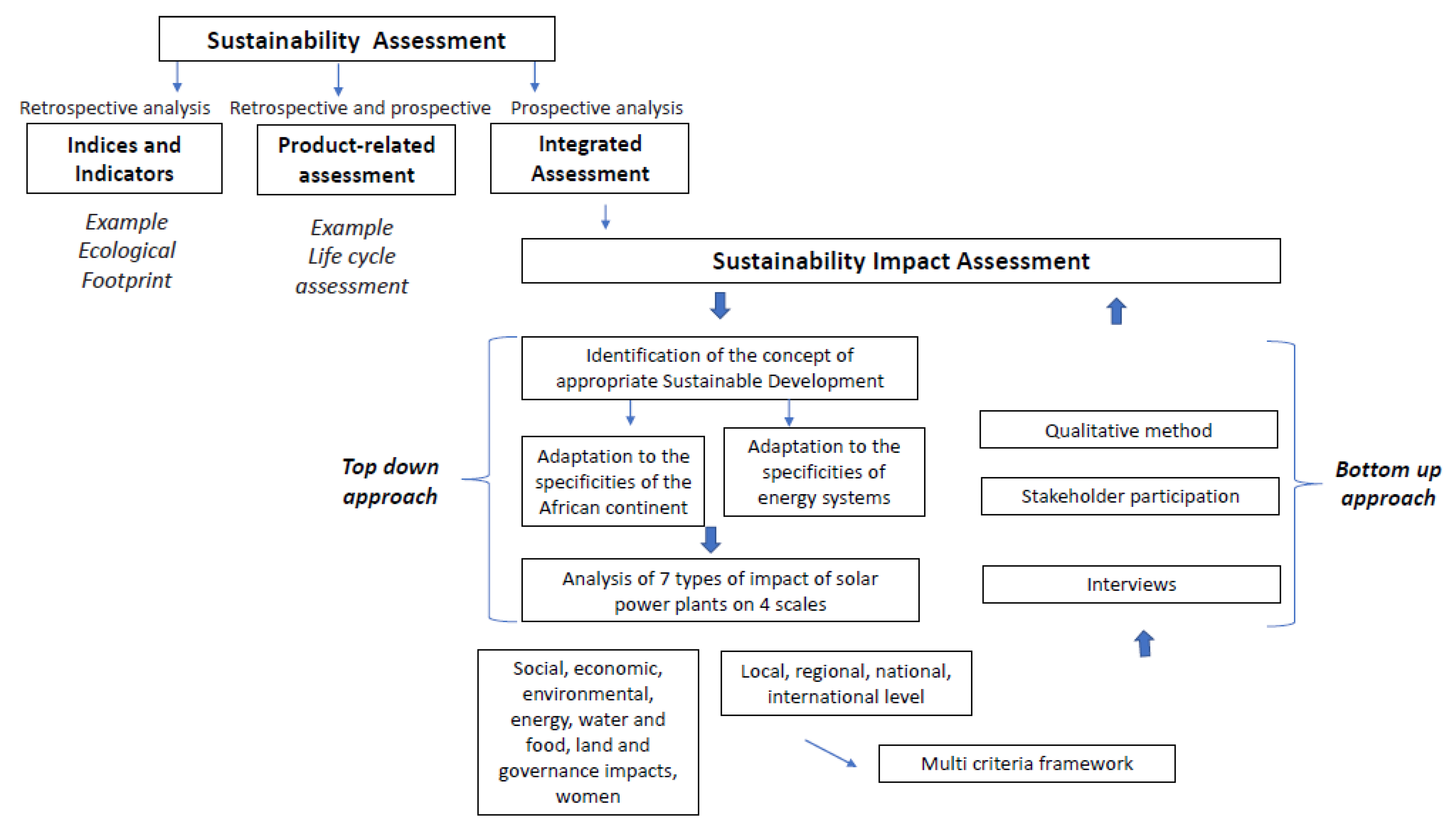
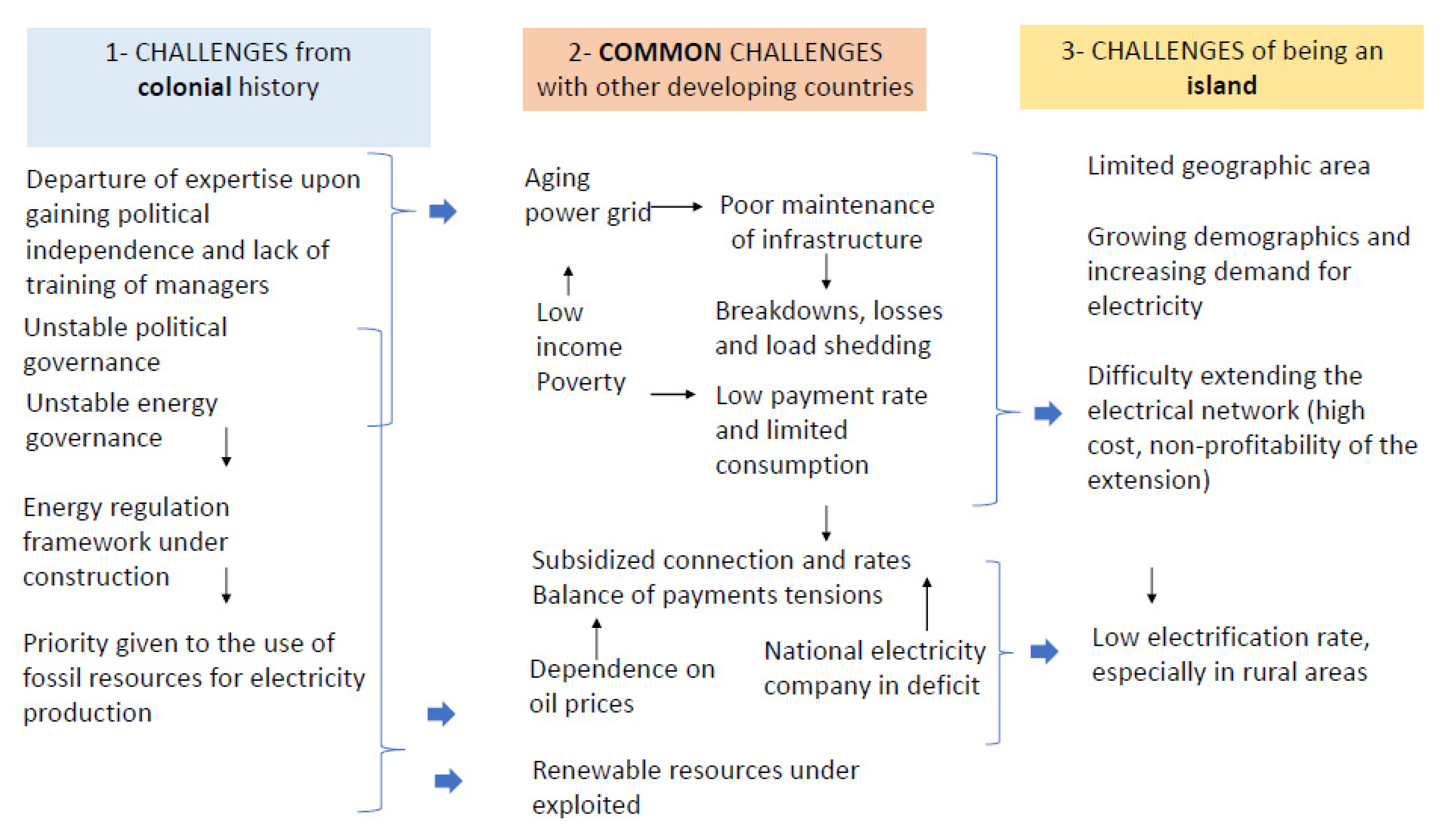
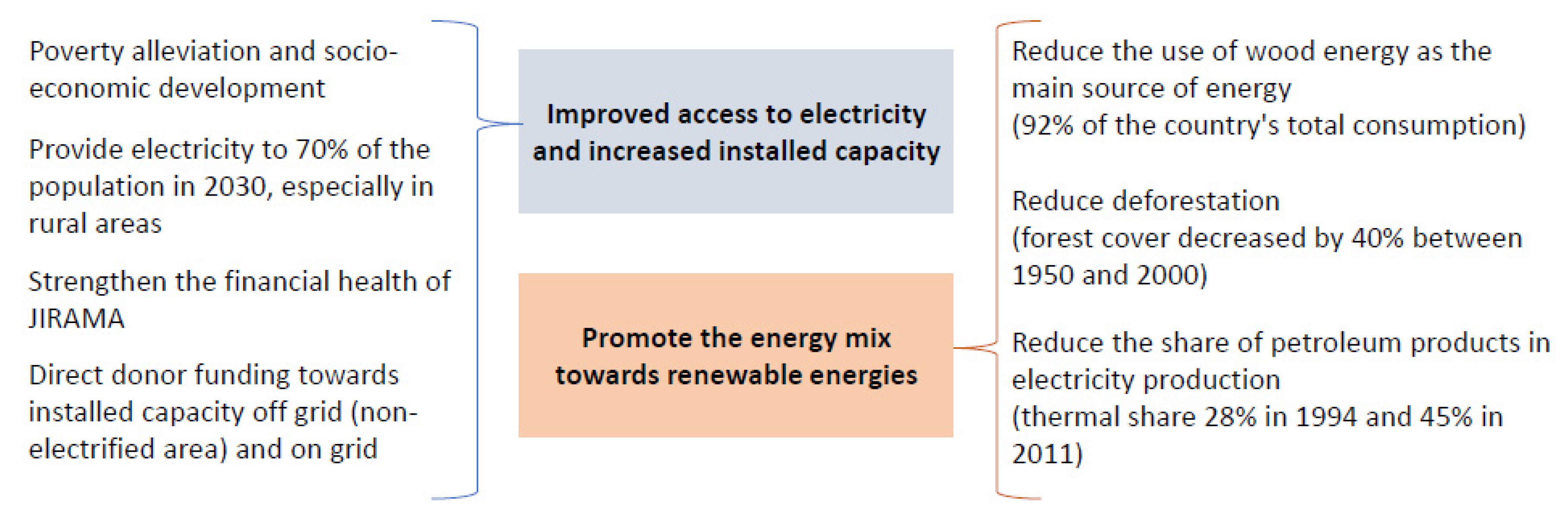
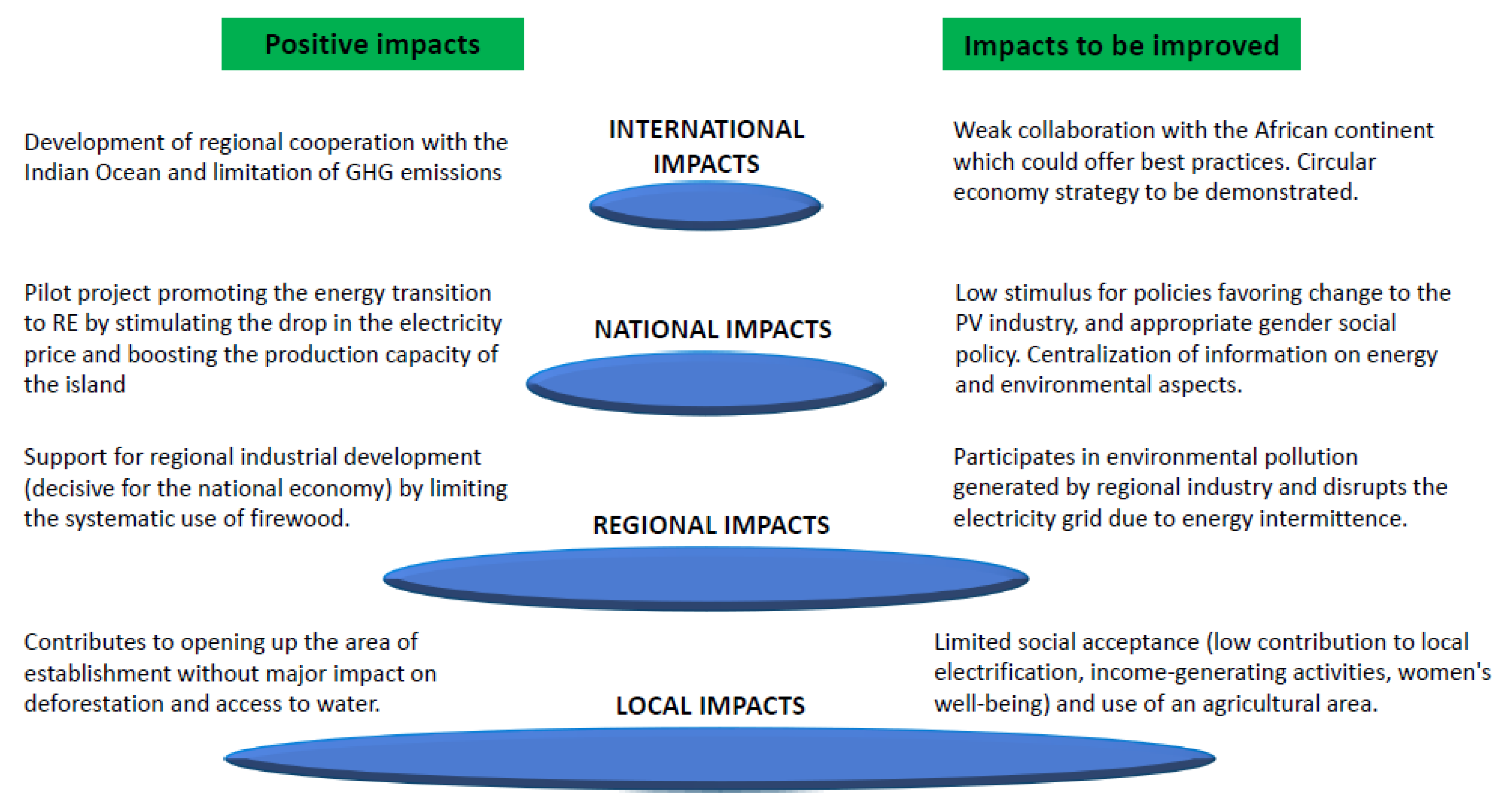

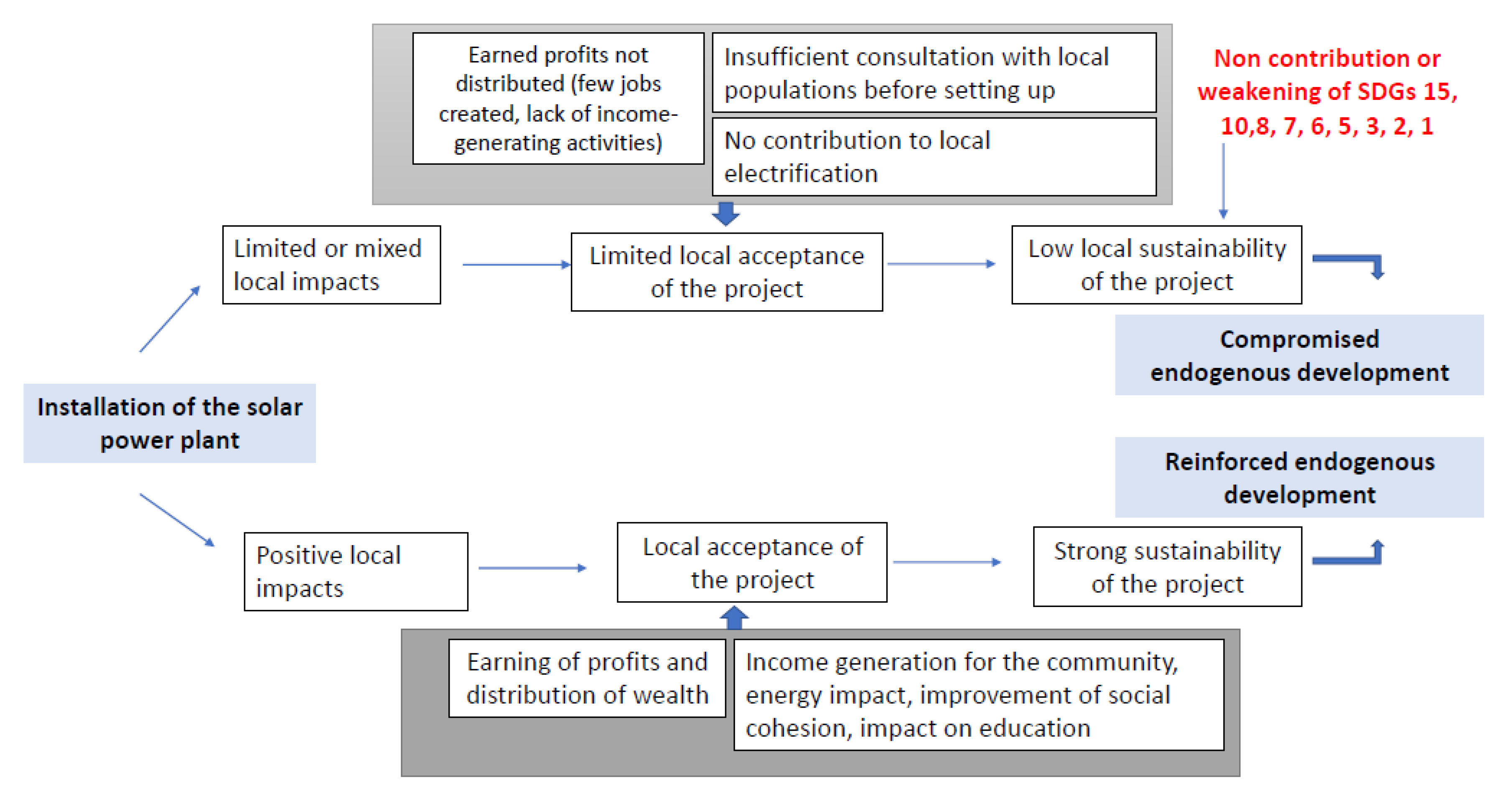

| Sex | Age (years) | Level of Education | |||||
|---|---|---|---|---|---|---|---|
| Male | Female | 18–25 | 26–46 | 46 and + | Unschooled or elementary level | High school | University |
| 39 | 40 | 13 | 41 | 25 | 32 | 22 | 25 |
| 79 | 79 | 79 | |||||
| GNI per Capita (USD) (2017) | 510 |
| GDP growth (annual %) (2018) | 4.6 |
| Total population (2018) | 26,262,000 |
| Population Density inhab/km2 (2018) | 45 |
| Population growth (annual %) (2018) | 2.7 |
| Surface area (sq. km) (2018) | 587,295 |
| % of total jobs in agriculture (2019) | 68% |
| Agricultural land (% of land area) (2016) | 71% |
| Proportion of GDP from Agriculture (2016) | 20% |
| Total unemployment (% of total labor force) (2019) | 1.6% |
| IDH 2018–Category | 162–Low |
| Poverty headcount ratio at $1.90 a day (2012) (% of population) | 77% |
| CO2 emissions (metric tons per capita) (2014) | 0.1 |
| Access to electricity (% of population) (2017) | 24% |
| Access to electricity, rural (% of rural population) (2017) | 17% |
| Unit Prices effective 2018 for 30 kWh/month in USD/kWh | 0.25 |
| Note: Although the economic growth has been relatively stable (around 5% over the last five years), its poverty rate remains high [92]. A large part of the economy is not monetarized due to a significant rural sector [93]. Madagascar is one of the least electrified countries on the African continent; the country is ranked 184th out of 190 countries in terms of access to electricity, which represents one of the main obstacles to the development of the country and the expansion of the private sector (World Bank “Doing Business”) [80,94]. The majority of consumers consume at a low voltage (99%) and consumption per capita is around 50 kWh/year [76,95]. Over the past twenty years, the demand for electricity has increased by 5% per year [96]. | |
| 2002 | 2012 | |
|---|---|---|
| Production (GWh) | ||
| Hydro power | 535 | 755 |
| Fossil Fuels | 245 | 595 |
| Solar Energy | 0.0008 | |
| Total | 780 | 1350 |
| Consumption (GWh) | 585 | 926 |
| Total | 585 | 926 |
| Total number of jobs for operation of the plant: 17 | 1 Development Director 1 O&M Manager (located in Mauritius) 1 Operations and maintenance manager 3 Operations managers (engineer) + 1 intern 10 cleaners: - Cleaning of the panels (2 truck drivers, 2 staff in charge of the Karcher, 2 cleaners, 1 supervisor). - Cleaning of premises (3 staff) |
| Number of permanent jobs | 5 |
| Number of temporary jobs | 7 (panel cleaning) 2 (cleaning of premises) |
| Number of positions occupied by women | 2 (cleaning of premises) |
| Security personnel | Subcontracted by a private company 12 guards including 2 policemen |
| Production in GWh | |
|---|---|
| 2018 | |
| July | 0.88 |
| August | 3.00 |
| September | 3.10 |
| October | 3.20 |
| November | 1.90 |
| December | 2.66 |
| 2019 | |
| January | 2.45 |
| February | 2.54 |
| March | 2.62 |
| April | 2.65 |
| May | 2.32 |
| June | 1.69 |
| TOTAL 2018–2019 | 29.01 |
| Sale price of electricity generated by the power plant (kWh) | Euro 12.5 c 480 Ariary |
| Electricity tariff in Madagascar (kWh) (Consumer price) | Euro 11.3 c (2018) 370 Ariary-exchange rate 3250 Ariary/Euro (2018) Euro 9.25 c (2019) 370 Ariary-exchange rate 4000 Ariary/Euro (2019) |
| kWh price-Thermal power stations (Gasoil, heavy fuel) | 1000 Ariary |
| Major Positive Impacts | Major Impacts to Be Improved | |
|---|---|---|
| International impacts | ||
| Economic | Promoting investment of an international private operator on equity | Importation of most of the equipment used by the power plant |
| Social | Sharing knowledge between the entities of the international private operator | Imperceptible impacts |
| Environmental | Reinforces the image of Madagascar as a protected natural space | Dynamics of circular economy at the scale of the sub-region to be demonstrated |
| Energy | Most powerful power plant in power in the Indian Ocean | Imperceptible impacts |
| Water and food | Imperceptible impacts | Lack of noticeable impacts |
| Governance and land | Contributes to giving a positive image in a context of risk/corruption | Organizations in the sub-region have limited take-up of RE |
| Women | Imperceptible impacts | Imperceptible impacts |
| National impacts | ||
| Economic | Stimulation of reduction in price of electricity supplied by RE | Does not participate in the development of the PV industry in Madagascar |
| Social | Capacity building and development of expertise | Imperceptible impacts |
| Environmental | Contributes to reducing dependence on fossil fuels | No access to the Environmental Impact Study (not public) |
| Energy | Increased energy capacity of the island | Electricity consumption peak does not correspond to the power plant’s production peak |
| Water and food | Imperceptible impacts | Imperceptible impacts |
| Governance and land | Establishment of the site supported by the State “presidential project”. | Centralization of decisions and information relating to the power plant at national level |
| Women | Imperceptible impacts | No drive for the development of a policy that favors women. |
| Regional impacts | ||
| Economic | Payment of an annual allowance to the Region | Lack of regional economic exchanges |
| Social | Imperceptible impacts | Imperceptible impacts |
| Environmental | Limiting the use of firewood in industries | Energy support for polluting industries |
| Energy | Support for local regional industry | Impact on the electricity network due to intermittent production |
| Water and food | Imperceptible impacts | Risk of energy support for polluting industries (wastewater discharges) |
| Governance and land | Payment of an annual allowance to the Region | Limited collaboration on the sharing of information about the power plant |
| Women | Imperceptible impacts | Imperceptible impacts |
| Local impacts | ||
| Economic | Well lit road promoting trade and security | No income-generating activities |
| Social | Large-scale solar awareness | Limited social acceptance |
| Environmental | Limited deforestation | Equipment end of life |
| Energy | Limitation of power cuts | No contribution to local electrification |
| Water and food | No negative impacts on access to water | Fertile area that can be used for local agriculture |
| Governance and land | Development of relations with the Fokontany | Limited consultation with local populations before installation |
| Women | 2 out of 13 employees are women | Women’s jobs are temporary and for the unskilled |
| The Solar Power Plant Supports or Contributes | The Solar Power Plant Supports or Does Not Contribute | Reason for Impairment or Non-Contribution | |
|---|---|---|---|
| International Level | SDG 13—Climate action | SDG 9—Industry, innovation and infrastructure | Importation of most of the equipment |
| SDG 9—Industry, innovation and infrastructure (promoting the investments of a private operator) | |||
| SDG 8—Decent work and economic growth | |||
| SDG 7—Clean and affordable energy | |||
| National Level | SDG 11—Sustainable cities and communities | SDG 9—Industry, innovation and infrastructure | Non-encouragement of a PV market, environmental and social impact study results were not made public, centralization of decisions and information relating to the plant |
| SDG 9—Industry, innovation and infrastructure (building national expertise) | |||
| SDG 8—Decent work and economic growth | |||
| SDG 7—Clean and affordable energy | |||
| Regional Level | SDG 11—Sustainable cities and communities | SDG 7—Affordable and clean energy | The production of the plant does not correspond to peak consumption, repercussions of intermittent production on the electricity grid |
| SDG 9—Industry, innovation and infrastructure | SDG 6—Clean water and sanitation | Development of polluting industries using energy generated by the power plant | |
| SDG 8—Decent work and economic growth | |||
| SDG 7—Clean and affordable energy | |||
| Local Level | SDG 16—Peace, justice and strong institutions (fees paid to the commune) | SDG 15—to be confirmed | Impact of night light on biodiversity |
| SDG 15—Life on land (trees preserved) | SDG 10—Reducing inequalities | Inequalities between households with electricity and those without | |
| SDG 11—Sustainable cities and communities | SDG 8—Decent work and economic growth | No impact on income-generating activities | |
| SDG 8—Decent work and economic growth (job creation) | SDG 7—Affordable and clean energy | Not available for local residents | |
| SDG 9—Industry, innovation and infrastructure | SDG 6—Clean water and sanitation (impact to be confirmed) | ||
| SDG 7—Clean and affordable energy | SDG 5—Gender equality | Women’s well-being affected or not support | |
| SDG 3—Good health and well-being for people (night light and security) | SDGs 1/2/3—no poverty, zero hunger, good health and well-being for people | Fertile area that could be used for cultivation, roads in poor condition, limited employment |
| Recommendations | Implementation of Recommendations | |
|---|---|---|
| Overall approach | Strategic environmental assessment integrating locally appropriate energy coverage | Government |
| Local level | Implementation of a strategic social plan Improvement of access roads Monitoring water consumption Use of IDA (International Dark Sky Reserve) standard * | Power plant |
| National level | Gender policy adapted to on-grid RE investments Rural electrification policy linked to on grid RE installations Provision of environmental and energy data Creation of a meteorological data network Implementation of the IDA standard * | Government |
| International level | Monitoring of RE policies used on the African continent, especially regarding local development [111,112] Anticipation of a circular economy strategy | Government |
© 2020 by the authors. Licensee MDPI, Basel, Switzerland. This article is an open access article distributed under the terms and conditions of the Creative Commons Attribution (CC BY) license (http://creativecommons.org/licenses/by/4.0/).
Share and Cite
Brunet, C.; Savadogo, O.; Baptiste, P.; Bouchard, M.A.; Rakotoary, J.C.; Ravoninjatovo, A.; Cholez, C.; Gendron, C.; Merveille, N. Impacts Generated by a Large-Scale Solar Photovoltaic Power Plant Can Lead to Conflicts between Sustainable Development Goals: A Review of Key Lessons Learned in Madagascar. Sustainability 2020, 12, 7471. https://doi.org/10.3390/su12187471
Brunet C, Savadogo O, Baptiste P, Bouchard MA, Rakotoary JC, Ravoninjatovo A, Cholez C, Gendron C, Merveille N. Impacts Generated by a Large-Scale Solar Photovoltaic Power Plant Can Lead to Conflicts between Sustainable Development Goals: A Review of Key Lessons Learned in Madagascar. Sustainability. 2020; 12(18):7471. https://doi.org/10.3390/su12187471
Chicago/Turabian StyleBrunet, Carole, Oumarou Savadogo, Pierre Baptiste, Michel A Bouchard, Jean Chrysostome Rakotoary, Andry Ravoninjatovo, Céline Cholez, Corinne Gendron, and Nicolas Merveille. 2020. "Impacts Generated by a Large-Scale Solar Photovoltaic Power Plant Can Lead to Conflicts between Sustainable Development Goals: A Review of Key Lessons Learned in Madagascar" Sustainability 12, no. 18: 7471. https://doi.org/10.3390/su12187471
APA StyleBrunet, C., Savadogo, O., Baptiste, P., Bouchard, M. A., Rakotoary, J. C., Ravoninjatovo, A., Cholez, C., Gendron, C., & Merveille, N. (2020). Impacts Generated by a Large-Scale Solar Photovoltaic Power Plant Can Lead to Conflicts between Sustainable Development Goals: A Review of Key Lessons Learned in Madagascar. Sustainability, 12(18), 7471. https://doi.org/10.3390/su12187471






